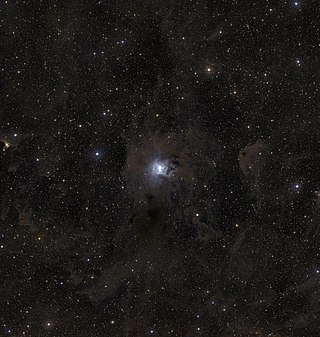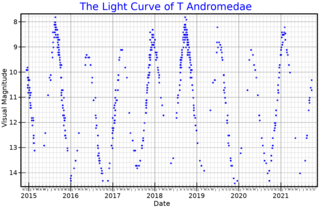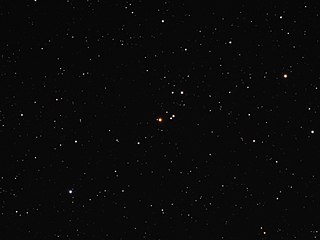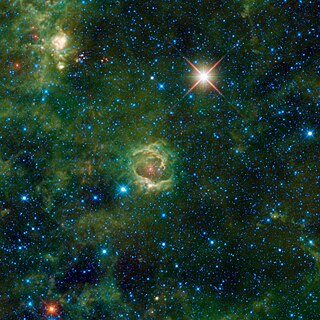
Chi Cygni is a Mira variable star in the constellation Cygnus, and also an S-type star. It is around 500 light years away.

R Hydrae, abbreviated R Hya, is a single star in the equatorial constellation of Hydra, about 2.7° to the east of Gamma Hydrae. It is a Mira-type variable that ranges in apparent visual magnitude from 3.5 down to 10.9 over a period of 389 days. At maximum brightness the star can be seen with the naked eye, while at minimum a telescope of at least 5 cm is needed. This star is located at a distance of approximately 410 light-years from the Sun based on parallax measurements, but is drifting closer with a radial velocity of −10 km/s.

28 Andromedae is a Delta Scuti variable star in the constellation Andromeda. 28 Andromedae is the Flamsteed designation. It also bears the variable star name GN Andromedae. Its apparent magnitude is 5.214, varying by less than 0.1 magnitudes.

63 Andromedae is an Alpha2 Canum Venaticorum variable star in the constellation Andromeda. Its variable star designation is PZ Andromedae. With an apparent magnitude of about 5.6, it is bright enough to be seen by naked eye. Based upon an annual parallax shift of 8.53 mas, it is located 382 light years away.

R Horologii is a red giant star approximately 1,000 light-years away in the southern constellation of Horologium. It is a Mira variable with a period of 404.83 days, ranging from apparent magnitude 4.7 to 14.3—one of the largest ranges in brightness known of stars in the night sky visible to the unaided eye. The star is losing mass at the rate of 5.9×10−7 M☉·y−1.

R Centauri is a Mira variable star in the constellation Centaurus.

T Cephei is a Mira variable star in the constellation Cepheus. Located approximately 600 light-years distant, it varies between magnitudes 5.2 and 11.3 over a period of around 388 days.

T Andromedae is a variable star of the Mira type in the constellation Andromeda. Like all the stars of this kind, T And is a cool asymptotic giant branch star of spectral type M4e-M7.5e. Its brightness varies periodically, completing a cycle in 281 days. The peak luminosity, however, is different every variability cycle, but can reach a peak magnitude mv=7.70.

S Persei is a red supergiant or hypergiant located near the Double Cluster in Perseus, north of the cluster NGC 869. It is a member of the Perseus OB1 association and one of the largest known stars. If placed in the Solar System, its photosphere would engulf the orbit of Jupiter. It is also a semiregular variable, a star whose variations are less regular than those of Mira variables.

NO Aurigae is a pulsating variable star in the constellation Auriga. It is an unusually-luminous asymptotic giant branch star about 3,500 light years away.

An S-type star is a cool giant with approximately equal quantities of carbon and oxygen in its atmosphere. The class was originally defined in 1922 by Paul Merrill for stars with unusual absorption lines and molecular bands now known to be due to s-process elements. The bands of zirconium monoxide (ZrO) are a defining feature of the S stars.

TX Piscium is a variable red giant star in the constellation Pisces. It is amongst the reddest naked eye stars, with a significant reddish hue when seen in binoculars. It is approximately 800 light years from Earth.

W Andromedae is a variable star in the constellation of Andromeda. It is classified as a Mira variable and S-type star, and varies from an apparent visual magnitude of 14.6 at minimum brightness to a magnitude of 6.7 at maximum brightness, with a period of approximately 397.3 days. The star is losing mass due to stellar winds at a rate of 2.79×10−7M☉/yr.

SU Andromedae is a carbon star in the constellation of Andromeda. It is a variable star classified as a slow irregular pulsating supergiant, and varies from an apparent visual magnitude of 8.5 at minimum brightness to a magnitude of 8.0 at maximum brightness with no clear period.

PZ Cassiopeiae is a red supergiant star located in the Cassiopeia constellation, and a semi-regular variable star.

S Canis Minoris is a variable star in the equatorial constellation Canis Minor. It has a peak apparent visual magnitude of 6.5, so not normally visible to the naked eye. The star is located at a distance of approximately 1,360 light-years from the Sun based on stellar parallax, and is drifting further away with a radial velocity of about +68 km/s.

W Aquilae is a variable star in the constellation of Aquila. It is a type of evolved star known as an S-type star. Due to its relatively close distance of 1,200 light-years and equatorial location, it is easy to observe and heavily studied.

S Cassiopeiae is a Mira variable and S-type star in the constellation Cassiopeia. It is an unusually cool star, rapidly losing mass and surrounded by dense gas and dust producing masers.

IK Tauri or NML Tauri is a Mira variable star located about 280 parsecs (910 ly) from the Sun in the zodiac constellation of Taurus.

TU Andromedae is a variable star of the Mira type in the constellation Andromeda. It has a spectral type of M5e and a visual magnitude which varies between extremes of 7.6 and 13.5.




















